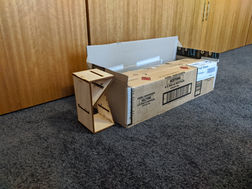Liefe
A compact easily assembled side table.
Brief
The objective of this project was to design a piece of furniture for small apartment dwellers where space and efficiency are the most important factors in furnishing a room. The final product must feature some ability to flat-pack either throughout its lifetime or for delivery. This piece of furniture is to be designed for a micro-apartment dweller aiming to maximise their living spaces.

Process
This project started out with an abundance of sketches laying out potential ideas with a combination of cardboard prototypes to help in evaluating the value of each. All these ideas were filtered down into 3 more refined concepts where they were evaluated by other designers.
Development
The Type-Z side table concept carried the most merit in its no tool flat-pack design, this offered users the best of both worlds in utility and compactness for when it's not needed. Further development was needed to refine the folding mechanisms and dimensions of the overall product. Small scale prototypes were useful in assessing the functionality and aesthetics of the product.
Initially, hinges were used for the small scale prototypes however these hinges were limited in their range, to give the parts a full range of motion a fabric hinge was developed. Nylon webbing and a laser-etched rebate gave enough space for the thin webbing to sandwich between two panels, centring the webbing to create a living hinge.
Final design
laser cut plywood and nylon webbing formed the final protoype as this was a proof of concept model, the final design as rendered would still use laser-cut plywood, however, instead of nylon webbing a more premium material such as leather was being considered. The cut-outs served to lighten the product both physically and visually, the organic design is intended to mimick forms found in nature, specifically how vines coil around other plants and objects.
























